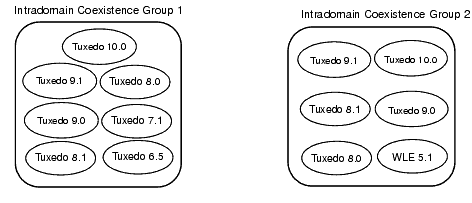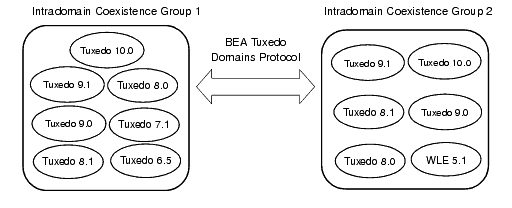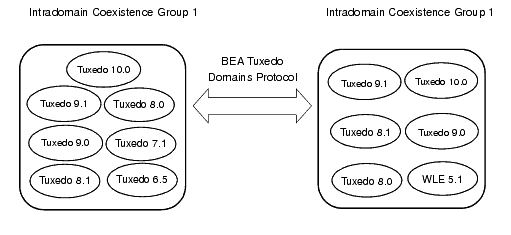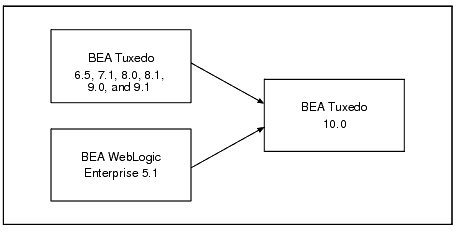









|
The following sections describe how BEA Tuxedo 10.0 interoperates with older releases of the BEA Tuxedo software, BEA WebLogic Enterprise, and third-party products:
Interoperability, as defined in this discussion, is the ability of the current release of BEA Tuxedo software to communicate over a network connection with BEA Tuxedo release 9.0 or earlier software or with BEA WebLogic Enterprise release 5.1 software. In addition, intradomain interoperability and interdomain interoperability have the following meanings:
Involves one machine in a multiple-machine BEA Tuxedo domain (application) running BEA Tuxedo release 10.0 software, and another machine in the same domain running BEA Tuxedo 9.1 or earlier software or BEA WebLogic Enterprise 5.1 software. Machines in a multiple-machine domain configuration communicate via Tuxedo Bridge processes.
Involves one BEA Tuxedo domain running BEA Tuxedo release 10.0 software, and another domain running BEA Tuxedo release 9.1 or earlier software or BEA WebLogic Enterprise release 5.1 software. Domains involved in a multiple-domain (Domains) configuration communicate via Tuxedo domain gateway processes.
Message exchange and protocol compatibility exist in each of the following two intradomain groups:

BEA Tuxedo 10.0 can coexist in the same domain with Tuxedo 9.1, 9.0, 8.1, 8.0, 7.1, and 6.5. BEA Tuxedo 10.0 can also coexist in the same domain with Tuxedo 9.1, 9.0, 8.1 and WebLogic Enterprise 5.1.
In both of these environments, the propagation of transaction context (transactional state information) and security context (user identity) between application clients and servers is fully supported. Also, administration is fully supported in both of these environments.
Message exchange and protocol compatibility exist in each of the following three interdomain scenarios:



In each of these scenarios, a Tuxedo domain (TDomain) gateway process running on a machine in the one domain communicates over a network connection with a TDomain gateway process running on a machine in the other domain. The following pairs of communicating TDomain gateway processes are supported.
Of course, the interdomain capabilities available through a pair of communicating TDomain processes are limited to the capabilities available to the TDomain process running in the earlier release of Tuxedo or WebLogic Enterprise software.
In all of these scenarios, administration, transaction context propagation, and security context propagation between domains is fully supported except when the master machine in the one domain is running Tuxedo 7.1 or 6.5 software and the master machine in the other domain is running WebLogic Enterprise 5.1 software. In any of these exception cases, administration is supported and transaction context propagation is supported, but security context propagation is not supported.
BEA Tuxedo 10.0 supports interdomain interoperability with Tuxedo 9.1, 9.0, 8.1 CORBA domains and with WebLogic Enterprise 5.1 CORBA domains. This capability includes the ability to advertise CORBA C++ factories across domain boundaries.
For interdomain transactional requests between Tuxedo 6.5 and other Tuxedo releases (6.5, 7.1, 8.0, 8.1, 9.0, 9.1, and 10.0), the following patch level upgrades must be applied:
This introduced a requirement for simultaneous patch upgrade for all interoperating domains involved. However, this simultaneous upgrade requirement might cause practical problems for applications that do staggered upgrades of patches. To mitigate such practical problems, TM_GWT_OLDSECCHECK is introduced to GWTDOMAIN and needs to be used until all interoperating domains are at least at the patch levels mentioned previously. Once all interoperating domains are upgraded, this environment variable can be eliminated from all domains.
To support customer migration, the following client-server interoperability is supported for BEA Tuxedo 10.0.
The capabilities available to a client for a particular client-server pair depend on the release of both the application client and the server application. For example, if you have a BEA Tuxedo 10.0 ATMI client interoperating with a BEA Tuxedo 6.5 server application, only BEA Tuxedo 6.5 functionality is available to the client.
Bootstrapping a BEA Tuxedo CORBA domain establishes communication between a CORBA application client and the domain. Two bootstrapping mechanisms are available: (1) the BEA mechanism using the Bootstrap object and (2) the CORBA Interoperable Naming Service (INS) bootstrapping mechanism specified by the OMG.
Support for INS was added in BEA Tuxedo release 8.0. With the addition of INS, third-party ORBs that use INS are able to interoperate with the BEA Tuxedo CORBA server ORB.

| Note: | The BEA Tuxedo CORBA client environmental objects continue to be supported in BEA Tuxedo 10.0, just as they were supported in BEA Tuxedo 8.0, 8.1, 9.0, 9.1 and BEA WebLogic Enterprise 5.1. |
A CORBA application client uses the BEA Tuxedo Bootstrap object or the INS bootstrapping mechanism to obtain references to the objects in a BEA Tuxedo CORBA domain. BEA client ORBs use the BEA mechanism, and third-party client ORBs use the CORBA INS mechanism. For more information about bootstrapping a BEA Tuxedo domain, see BEA Tuxedo CORBA Programming Reference.
The following figure shows the existing BEA Tuxedo and BEA WebLogic Enterprise products that can be upgraded to BEA Tuxedo 10.0.

If customers can shut down the domain (application) targeted for the upgrade, they should shut down the domain and perform a simple upgrade. If customers cannot shut down the domain targeted for the upgrade, they can perform a hot upgrade, that is, add the BEA Tuxedo 10.0 system software to the existing BEA Tuxedo or BEA WebLogic Enterprise domain without shutting down the domain.
For instructions on performing a simple upgrade or a hot upgrade, see Upgrading the BEA Tuxedo System to Release 10.0" in Installing the BEA Tuxedo System.
Applications developed with BEA Tuxedo 7.1, 8.0, 8.1, 9.0, and 9.1are upwardly compatible with the BEA Tuxedo 10.0 release; however, relinking may be necessary. Specifically, applications built on these Tuxedo releases are binary upward compatible; they can run unchanged on BEA Tuxedo 10.0 software.
Tuxedo 6.x applications must be recompiled to run on Tuxedo 10.0. Existing WLE 5.1 and earlier applications must be regenerated, recompiled, and relinked to run on Tuxedo 10.0.
| Notes: | For XML-related applications, you must conform to Xerces C++ 2.5 interface requirements. |
| Note: | On Windows platform, the binary must be relinked if FML-related functions are used. |


|